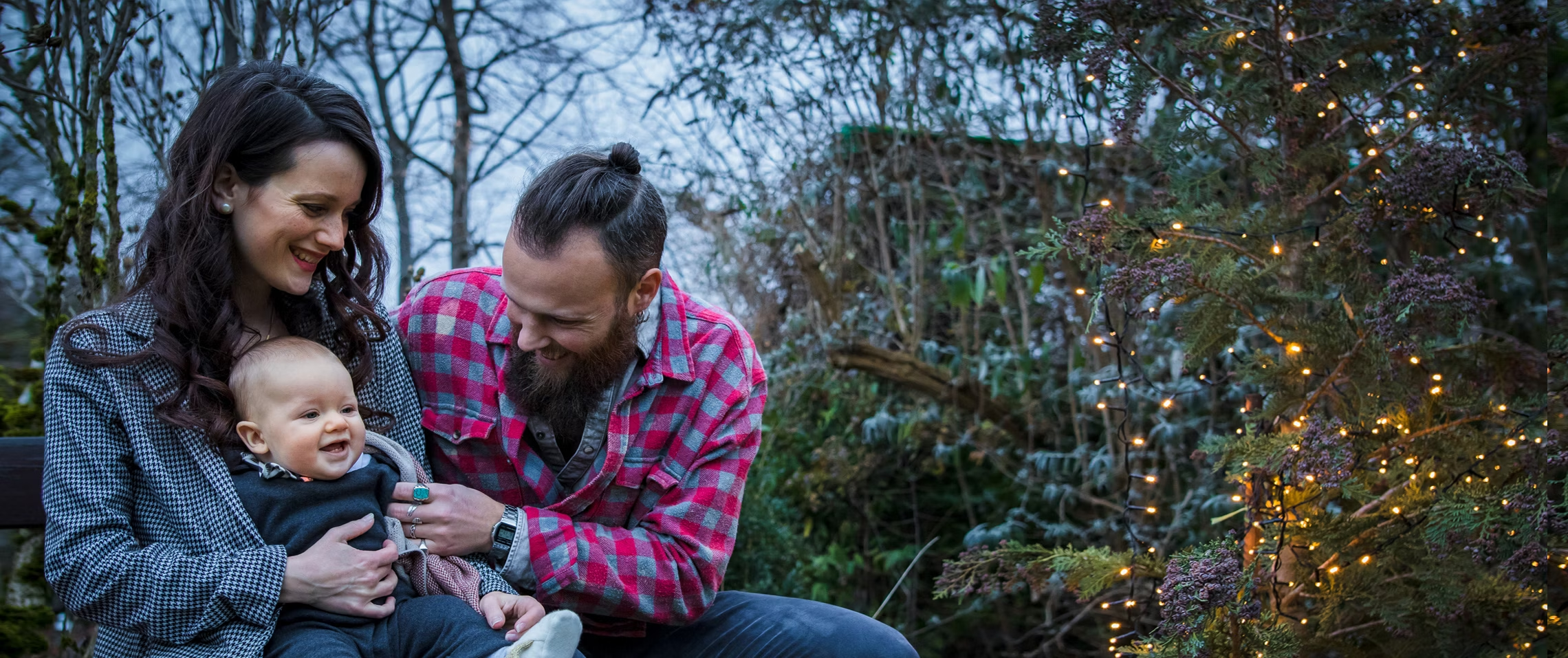 Photo by Gabriel Kiener via Unsplash
Photo by Gabriel Kiener via UnsplashTRAVELING WITH AN INFANT: WHEN IS IT SAFE TO TRAVEL WITH A NEWBORN BABY BY PLANE, CAR OR TRAIN? (2023 UPDATE)
Not only is it safe to travel with most newborns, whether flying, driving, riding a bus, or taking a train or other mass transit, here’s some even better news: You and your family don’t have to give up on your travel dreams.
Here are three of the most popular ways to travel – car, train, and plane – and some of the best tips for safe travel with a newborn from family travel experts.
GENERAL TIPS FOR TRAVELING WITH NEWBORNS
When Dan and Celine Brewer had their first child, “People were telling us, ‘Your traveling days are over,’ and my husband and I were like, ‘No way!’”
The Brewers created and maintain the highly popular and informative Baby Can Travel blog and Instagram site.
“So we made a promise while I was pregnant that if our baby was healthy we were going to do a trip as soon as we could.”
Their daughter was three months old when they took her from Canada to Barcelona. Since then, the Brewers have kept their promise to keep traveling with their kids, now nine and seven.
While the Brewers are a little bit removed from day-to-day life with a newborn, they live through other parents on their blog.
Here are some of their top general tips for traveling for newborns.
Be prepared to wash some clothes
A baby needs far fewer outfits than you, but they need to be clean. Also, the collateral damage from mega-blowouts should be dealt with promptly.
Doing baby laundry on the road is easy. If you’re staying in one place for more than several days, ask about laundry facilities; otherwise, pack some concentrated detergent and a clothesline and DIY.
Look into babysitter services and/or apps
There are very reputable sitter services in many major cities. Many are accessible through a site or app, like UrbanSitter, Care.com, and Sittercity.
In places where you have friends, ask them to connect you with a sitter. You can also ask your Airbnb host or the hotel concierge for recommendations.
Whatever you choose, make sure you’re comfortable with the process and the person watching your child. Remember: it’s your baby!
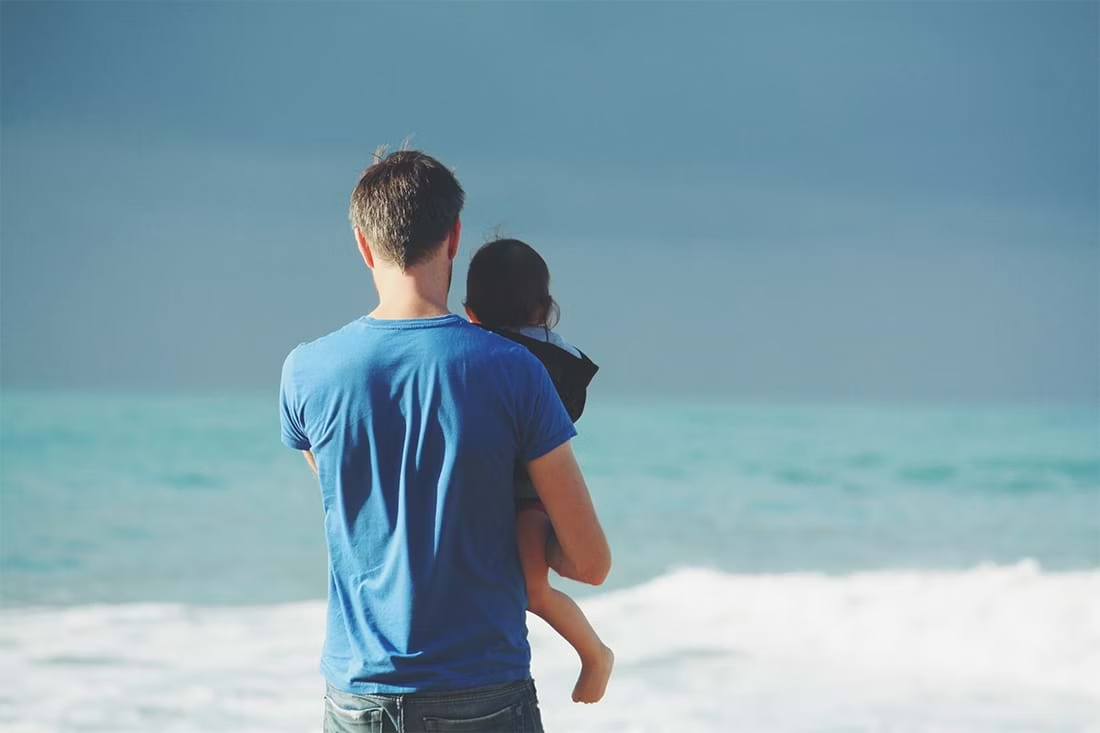 Photo by Steven Van Loy on Unsplash
Photo by Steven Van Loy on Unsplash
Choose an easy destination
Select a relaxing destination that’s used to the very youngest travelers. Skipping the loud, crowded, overstimulating, touristy destinations will make things more bearable for everyone.
Consider a beach retreat or a resort with larger rooms or family suites, ideally one that offers infant care sufficient for you to have some alone time.
Eventually the crowded, overstimulated, plenty-of-activity kind of resorts will be just what the family needs. But for now, just keep it simple and make the adjustment period more enjoyable for everyone.
Simplify your schedule
If you limit yourself to one activity a day, you’ll find it much easier to make last-minute adjustments.
Also, “end your day early, so everyone has time to unwind,” says former travel professional and resort expert Cat Zuniga. “Even when you’re on vacation, you have to catch up on rest whenever and wherever you can!”
Similarly, if an activity or meal is a fail, don’t try to push through it. Go back to your lodgings and give something else a shot later on.
Take care of yourself
You’ll have more energy and stamina – and enjoy the trip more – if you take care of yourself when you travel.
Resist loading up on sugary snacks, and falling into “I’m on vacation so I’ll eat anything I want” mode. Re-energize with exercise; for instance, do some easy foot lifts while you’re seated.
Take turns
Make an agreement with your significant other to give each other vacation days during the vacation, where one will watch the kids while the other does something fun.
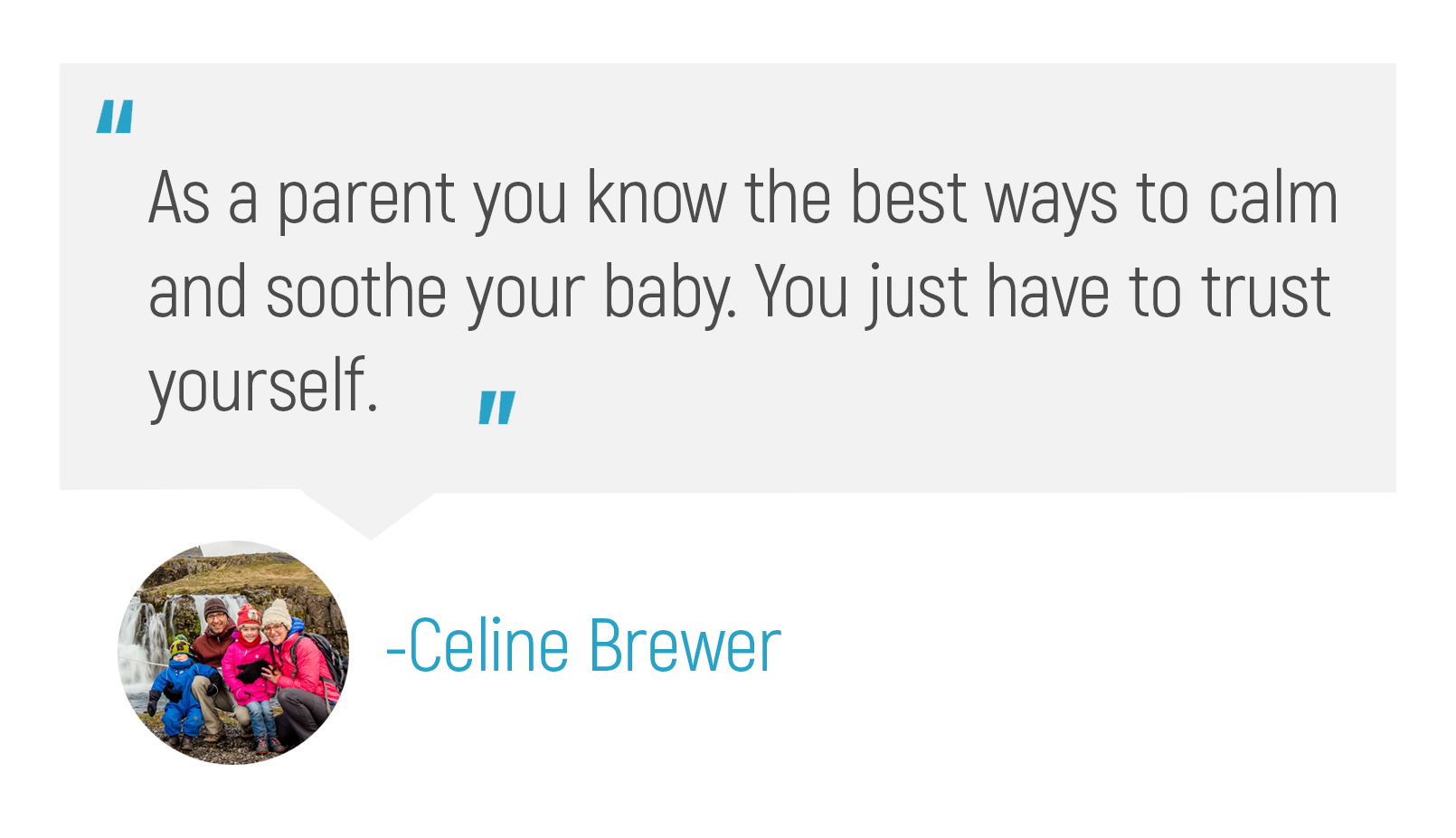
Trust yourself
“Babies can really feed off your energy,” Brewer says. “But as a parent you know the best ways to calm and soothe your baby. You just have to trust yourself.”
If you feel the situation getting out of hand, close your eyes and take a few deep breaths. You’ve got this.
Chill
If you haven’t already figured it out, so often the best advice is to relax and stay flexible.
“We’ve had some bad trips where we were up at night with a screaming baby in a hotel, and you know what? We just changed our style,” Brewer says. “We slowed down, we experimented, we talked about what worked and what didn’t, we went back to our Airbnb for naps, and it was wonderful.
“Just don’t give up.”
FAQs
When can you travel internationally with a baby?
On most airlines, a baby has to be more than one week old to fly.
In general, you should get approval from your pediatrician before traveling internationally with a child less than six months old. Also remember that your baby needs their own passport.
Once you’re actually in a new country, there are few restrictions on travel via train, car, bus, or metro, provided you have the appropriate safety equipment.
If you don’t carry the appropriate car seats, infant carriers and other safety equipment, make sure it’s available for rent at your destination.
In addition, travel insurance is recommended for international travel with a newborn, because of its coverage for trip cancellation, trip interruption, and medical emergencies.
When is it safe to travel overseas with a newborn?
You can travel overseas with newborns as young as seven days. However, you should check with your pediatrician before going on any major travel with a newborn – especially overseas travel.
If you’re planning an overseas trip with your newborn as soon as it’s feasible for your child to travel, you may have to have initial conversations with your doctor prior to the baby’s birth, with follow-up discussions afterwards.
Because of the amount of uncertainty with this sort of trip, travel insurance with trip cancellation coverage is vital. Travel insurance is also important for its ability to cover medical emergencies.
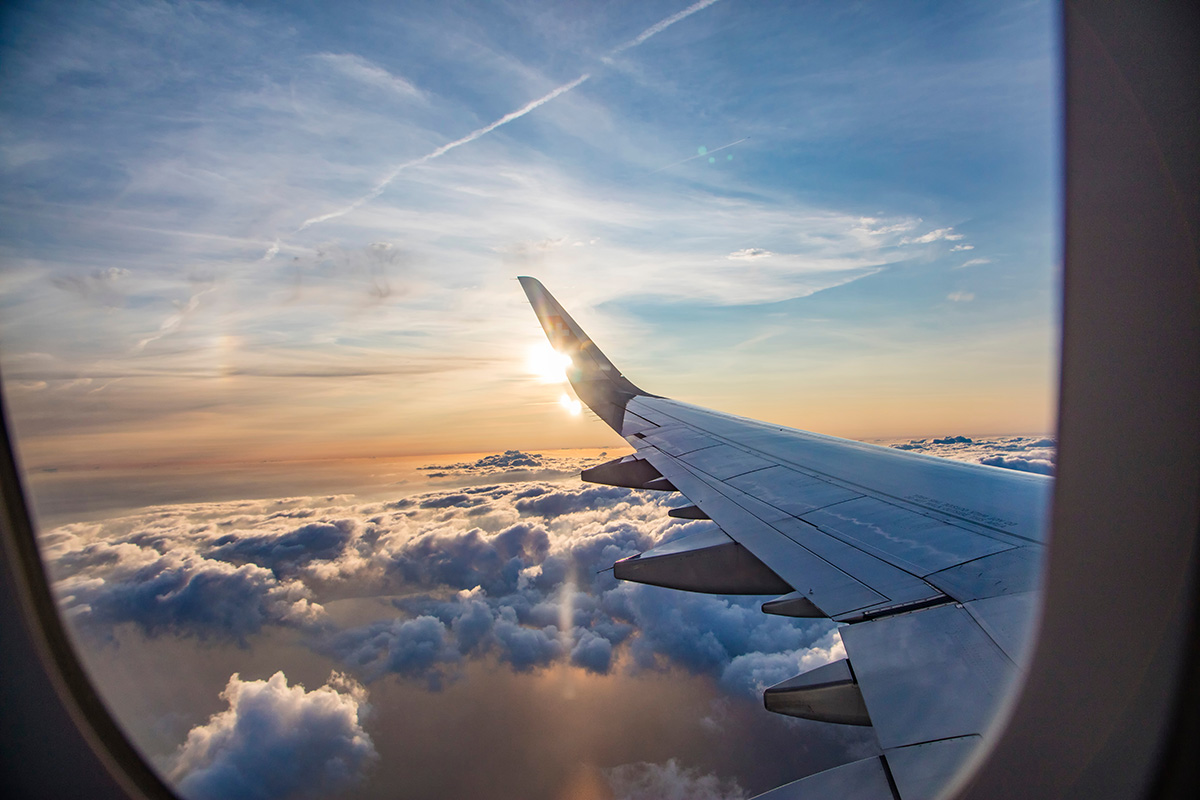
FLYING WITH AN INFANT: WHEN IS IT SAFE TO TRAVEL WITH A NEWBORN BABY BY PLANE?
In general, doctors recommend you wait to fly until your baby’s immune system is better developed. This could be as soon as one month for full-term infants, though most doctors recommend anywhere between three months and six months.
Premature babies or babies with heart or lung problems may have difficulty breathing because of the lower air pressure in an airplane cabin. If that’s your child, talk to your pediatrician before flying.
Airlines differ in their policies on infants flying. On Delta, a baby has to be more than one week old to travel. Younger infants can travel with a doctor’s permission. JetBlue lowers the standard to three days old.
United refuses to allow a baby younger than seven days old onboard under any circumstances. United also bans infants in incubators.
No matter what, if planning to travel with baby on board, always check with your pediatrician first.
Because of the difficulties inherent in booking flights for an entire family, including a newborn, it also makes sense to look into flight protection, in case flights are cancelled or delayed, or if flight issues cause you to miss a connection.
(And should you actually decide to cruise with a newborn, Berkshire Hathaway Travel Protection can cover that as well.)
Tips for flying with a newborn
Flying with a newborn can be challenging for everyone – parents, fellow travelers, and the baby. However, with a little advance prep everyone can get through it just fine. Here are some tips to ease the stress of flying with a baby.
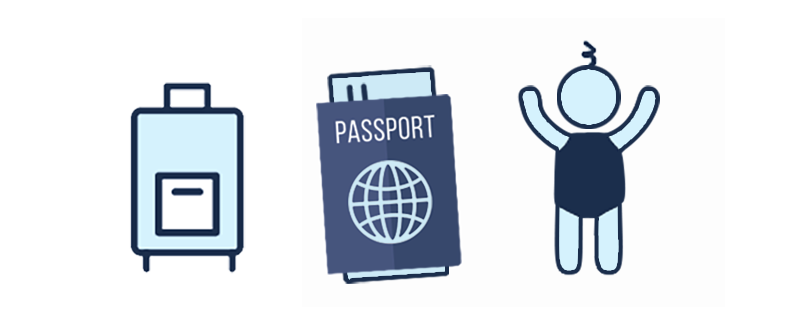
Don’t forget the birth certificate and passport
A birth certificate can establish that an infant is young enough to fly on your lap – or old enough to fly, period.
When traveling outside the United States, babies need their own passport, just like every other family member.
However, a passport requires a birth certificate, and you probably won’t get a birth certificate the day your baby is born.
While you’re waiting for the birth certificate to be processed, fill out the passport application and take your baby’s passport photos.
These aren’t typical passport photos. You’ll want to put your baby on a white sheet and shoot from above.
Can you shoot an acceptable photo on your phone? Probably. The passport agency is often more lenient with infant photos.
As soon as you get the birth certificate, apply in person at the nearest office that accepts passport applications. If necessary, pay extra to expedite the application.
If you live near a passport agency, make an appointment there instead. It’s the fastest way to get a passport.
Make smart reservations
Book early and/or pay extra so you’re not stuck in middle seats.
Be aware of your baby’s routines, especially bedtimes and nap times, and look for flights when your baby is more apt to sleep.
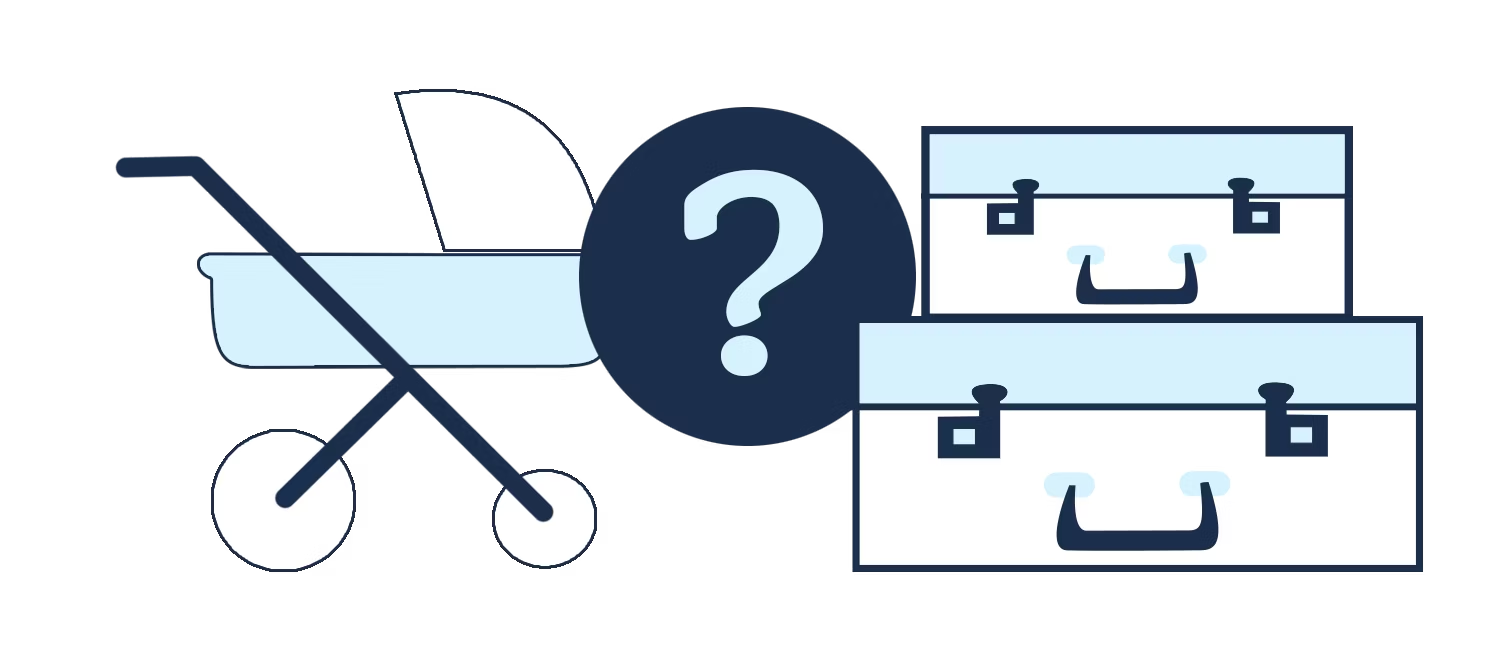
Question bringing everything
When you pack, ask yourself if you have to bring along 1,500 diapers, a gross of wipes, or even such seeming essentials as a stroller or car seat.
“Don’t overpack,” Brewer emphasizes. “You’re going to have enough to deal with with your baby without having to worry about all your stuff. Have changing and diaper stuff at the top of your bag so it’s easy to grab, but don’t bring too much stuff.”
As for not bringing a car seat or stroller, the Brewers looked for locations where they could rent these items or leave them home. When they did, Celine Brewer says, “We were like, ‘Ah! This is amazing!’”
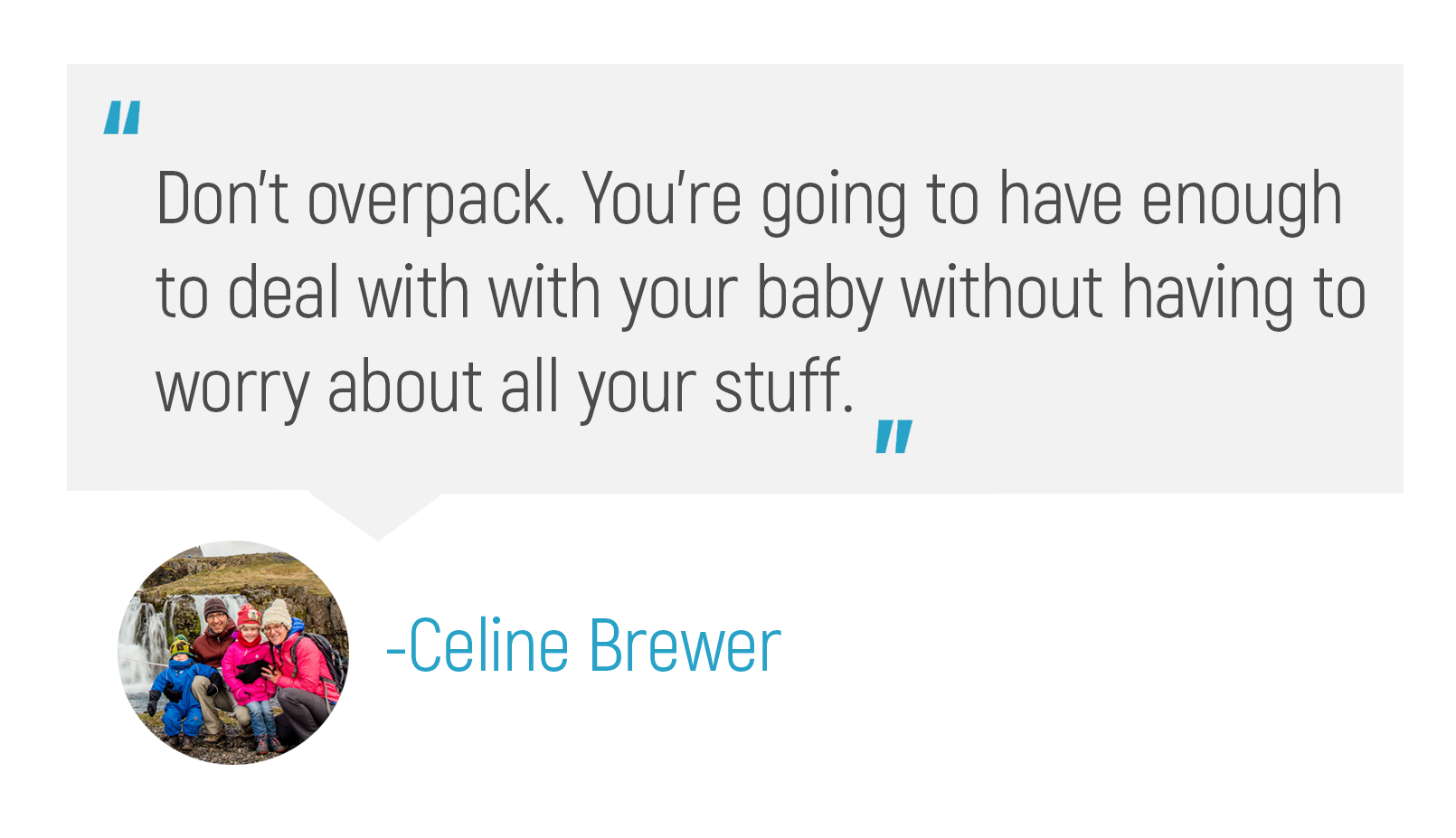
But don’t forget the go-tos
“You can basically get through with wipes, food, and diapers,” Brewer says, “but the other thing I would always bring is one of those really big, lightweight cotton swaddle blankets. We’d use it for everything – for a nursing cover, to lay on the ground, to put the baby on, and so much more.”
Bring the fuel
Newborns can easily get dehydrated when they’re in the dry atmosphere of an airplane cabin. You know what your child wants/needs, so make sure there’s plenty of it.
If you’re breastfeeding, staying hydrated is a must; if you’re pumping, pump extra and keep it on hand. Always be prepared for the worst-case scenario.
Expert tip: The TSA’s 3-1-1 rule doesn’t apply to formula, breast milk, and juice. Just make sure you have liquids in a baby bottle. Also, freeze packs, liquid or gel teethers, and baby food are allowed in your carry-on.

Board strategically
Take full advantage of the early-boarding invitation for passengers, but don't actually board your baby.
If you can spare the hands, send an adult on to prep the seats, stow the diaper bags, and arrange swaps if necessary. Then board your baby at the very end of the line to avoid the stampede.
Suck at takeoff
Babies do well with nursing or taking a bottle at takeoff, so the closer you can synchronize takeoff time and feeding time, the better. A pacifier is also an option for baby during takeoff.
Make friends with the flight attendants …
“… because guess who can help you along the way?” Brewer says. “I’ll even make friends with the people who are waiting at the gate. Get your baby smiling and happy, so all the people will go, ‘Aw – sweet thing!’”
The more allies you can have on your side the better, in other words.
Let someone (or something) else handle your bags
Curbside check-in and/or a skycap will make luggage handling much less of a chore. Tip accordingly ($1/bag is standard).
If you’re bringing a stroller, buy an umbrella stroller you won't mind losing. If you're traveling with your child on your lap, call the airline ahead of time to confirm rules about strollers, car seats, and carry-on luggage.
You’ll quickly learn that strollers can double as luggage carriers. Check yours at the gate and grab it when you head to your next destination, and fill it with stuff along the way, if you’re not using it to tote Junior.
You may be pleasantly surprised by the baggage allotments provided to children flying in-lap, since a child is not counted as your own carry-on.
Keep lots of wipes on hand
Is there anything that baby wipes can’t do, other than actually change the diaper for you?
“Bring along wipes for a good cleanup if you’re in an airport or on an airplane – they’re some of the filthiest places you’ll find,” says award-winning travel advisor and blogger Cat Zuniga. In addition, baby wipes let you make a quick wipe-down on a messy baby.
Baby wipes also work on grownups, who sometimes feel like they could use a hose-down after an encounter with a baby’s diaper.
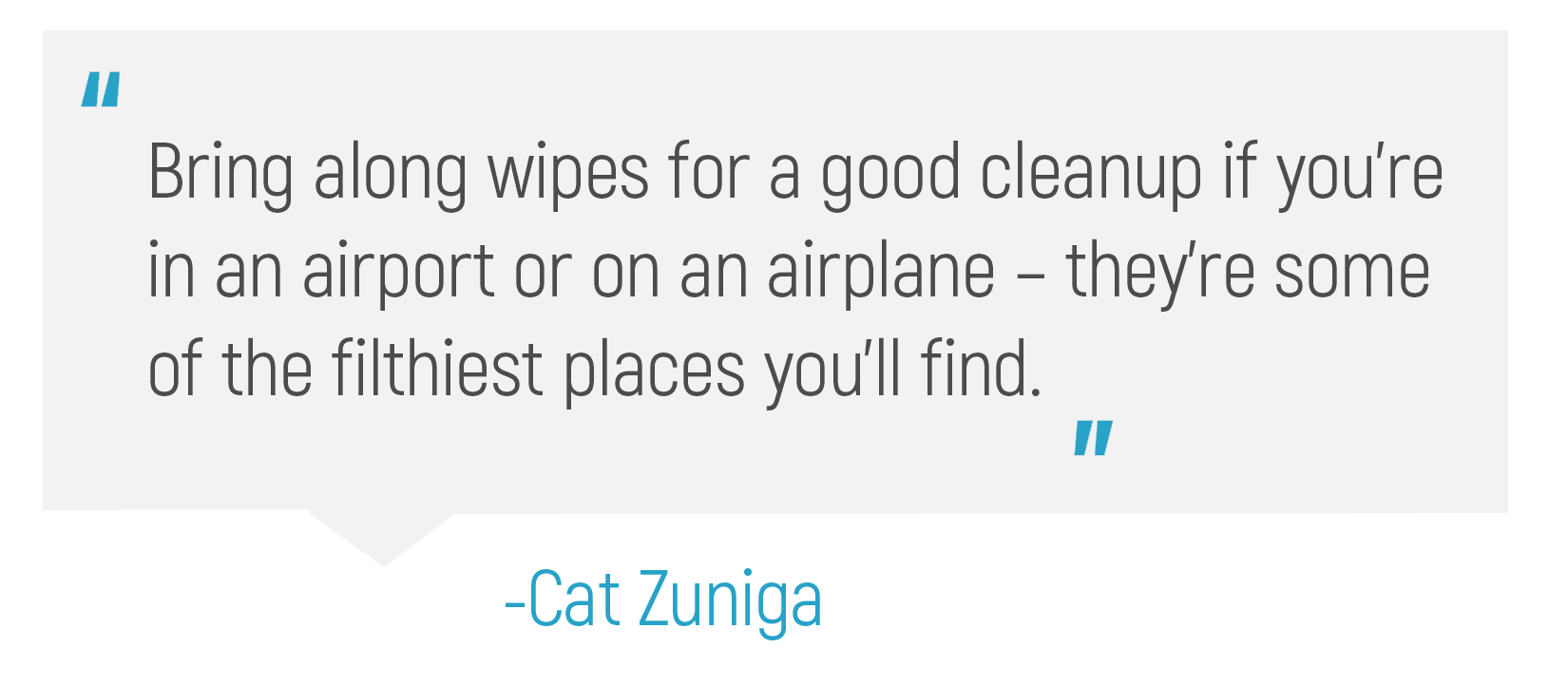
Apologize
“You can’t stop your baby from crying on a plane any more than you can at home,” Brewer says. “Babies and toddlers cry; that’s what they do. And sometimes we have to accept that people around us are going to be unhappy about that. But if you’re doing your best to soothe your baby, what more can people ask for?”
Not much more than a simple apology. When you sincerely apologize in these situations, you're more likely to get sympathetic nods instead of hostility.
FAQs
When can a baby fly on a plane?
The earliest a baby can fly on a plane is seven days. However, most pediatricians recommend that parents hold off on flying with their newborn until their respiratory and immune systems are better developed.
This time varies among babies; full-term babies may be ready to fly at one month, though most doctors recommend waiting until your baby is three to six months old before flying.
Premature babies or babies with heart or lung problems may have to wait longer before being able to fly, as they may have difficulty breathing because of the lower air pressure in an airplane cabin. If that’s your child, talk to your pediatrician before flying.
When can a baby fly internationally on a plane?
In general, pediatricians recommend that newborns not fly until their respiratory and immune systems are fully developed. This often means that a newborn should not fly until they’re three to six months old.
However, these dates can vary greatly from child to child. Some pediatricians will allow some babies as young as one month old to fly internationally. Always check with your pediatrician.
Because infants are more susceptible to many types of illnesses and infections, travel plans need to be flexible.
Since this doesn’t always align with international travel, it’s important for parents traveling with newborns to buy travel insurance with comprehensive coverage for trip cancellation, trip interruption, and medical emergencies.
Finally, remember that newborns need their own passport to travel internationally.
CRUISING WITH AN INFANT: WHEN CAN A NEWBORN BABY SAFELY TRAVEL ON A CRUISE SHIP?
The basic answer to the question when parents can safely take a newborn on a cruise is: When they’re not a newborn anymore.
According to Cruise Critic, most cruise lines require a baby to be at least six months old to go on a cruise.
It’s not just because cruise ships don’t want crying babies at all hours, because they get those anyway when the shrimp buffet runs out.
Many cruise ships simply aren’t set up to accommodate the super-young. For instance, many ships lack:
- Diapers and wipes for sale in the gift shop
- Facilities for warming up bottles
- Places to wash bottles
- Baby bathtubs
- Child care for the very young
- Facilities to prepare baby food
In addition, medical care, while available, may not have specialized equipment to deal with very young babies.
Some of the most enjoyable parts of cruises are off-limits to babies as well. These include:
- Shore excursions
- Pools, rides and games
Adding it all up, a cruise-ship vacation with a baby may not be that much of a vacation. It might be worth putting it off when everyone’s better able to enjoy it.
Tips for cruise ship travel with a newborn
Wait. And look at cruises again once your child is older than six months.
FAQs
Can you bring a newborn on a cruise?
Cruise ships generally don’t allow babies younger than six months onboard.
As for babies older than six months, only you can decide if you should take your older baby on a cruise.
Cruise destinations may not have medical care as good as what can be found at home. Also, you probably won’t be able to do shore excursions with your baby, and your ability to take in the nightlife may be impacted.
In addition, not all cruise ships have the wherewithal to support babies on board (though – no surprise – Disney cruises do).
When is it safe to travel on a cruise with a newborn?
When your baby isn’t a newborn any longer, essentially.
A baby must be six months or older to cruise on most ships, with the exception of some adults-only ships. Special itineraries, like cruises to exotic destinations, long ocean crossings and round-the-world cruises, require kids to be one year or older.
You may find the cruise experience to be quite different when you’re cruising with a baby. For instance:
- Pools and most other activities are off-limits
- Laundry facilities may not be available
- Bathrooms may lack tubs for babies
- Kitchens may not be willing to puree foods for babies
- Gift shops often do not stock diapers and wipes
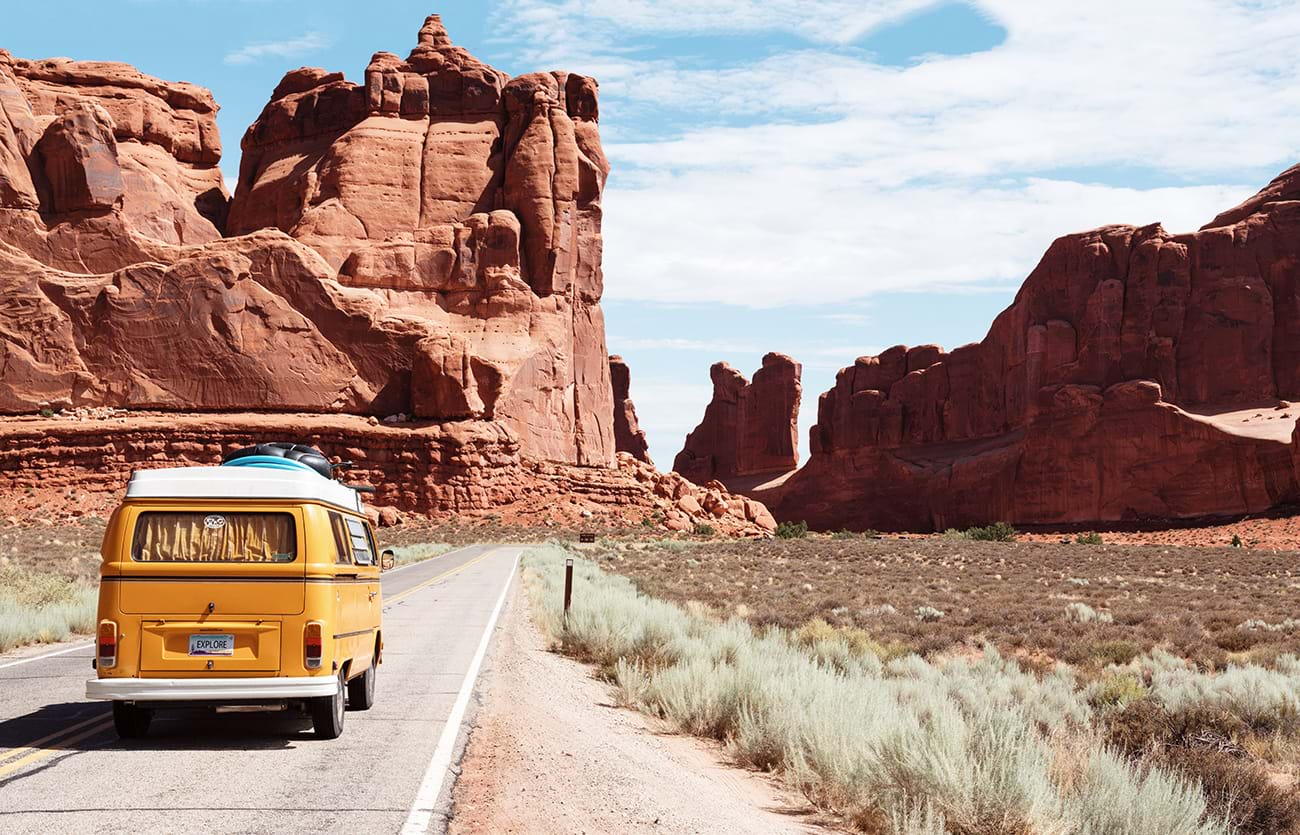 Photo by Dino Reichmuth on Unsplash
Photo by Dino Reichmuth on Unsplash
DRIVING WITH AN INFANT: WHEN CAN A NEWBORN BABY SAFELY TRAVEL BY CAR?
Your newborn probably arrived home by car, so there are no real restrictions on road trips, other than the general reminder about immune-system development.
However, everyone will probably need a break every hour or so for feedings, changings, and cuddling.
Tips for driving with a newborn
Drive in comfort
If there’s such a thing as a sleep schedule, try to plan car travel to coincide with sleep time.
“We’d get up at 4 or 4:30, wake up our baby, put her in the car, and get a big chunk of our driving down first thing in the morning,” Brewer says. “She didn’t always go back to sleep, but she was always very quiet and content. Then we’d stop for lunch, and finish up the drive during her nap.”
Dress infants comfortably – loose clothing or pajamas, and blankets – and use removable window shades to keep off the sun.
Keep in mind that ideal car-sleeping temperature is cooler than you might expect; adjust the climate control accordingly.
Take practice trips
To get an idea for what works for your little one when on the road, take several short day trips or weekend getaways in advance of a big trip.
Zuniga says these trial runs are important “because they’re going to tell you what supplies you should pack, how long your newborn can last in a car seat, and what’s going to drive you nuts.”

Pack sounds
Music should be plentiful and dependable. You can have a playlist on your phone with kids' favorites, but that can burn data and/or suck battery life.
If you’re driving and your car stereo supports it, load MP3s onto data CDs. That will get you 100 to 150 tracks per disc –more than enough for any road trip. You can gingerly retake control of the playlist once baby has nodded off.
If you need some white noise for bedtime, use RainyMood.com or download the RainyMood app.
FAQs
When can you travel with a newborn by car?
You can travel by car with a newborn as soon as your newborn is able to leave the hospital. In fact, the first trip your newborn will take will likely be in your car.
For many people, the trip home from the hospital is 15 minutes or less. However, for some the trip home will be significantly longer, or that quick trip home will be followed shortly by a longer road trip to see grandparents or great grandparents.
Road trips, like every other type of travel, should be approached with flexibility. Lots of breaks are to be expected, for changing, feeding and just a change of surroundings. Some “cuddle time” is probably in order as well.
Is it safe to travel with a newborn by car?
Traveling with a newborn by car can be safe if certain precautions are taken. Here are some important tips to ensure a safe journey with your little one:
- Use a rear-facing car seat: Choose a car seat specifically designed for newborns and install it according to manufacturer instructions.
- Secure the car seat properly: Secure the car seat to the vehicle seat using the seat belt or LATCH system. The seat should be snug.
- Avoid long journeys: Limit the duration of car trips. Frequent stops are necessary to feed, change, and comfort the baby.
- Check the car's temperature: Maintain a comfortable temperature in the car. Avoid extreme heat or cold.
- Pack essentials: Carry essential items like diapers, wipes, extra clothes, and blankets. Be prepared for unexpected situations.
- Plan for breaks: Breaks in your travel itinerary will give the baby and parents some rest. Stretching and moving around will help prevent fatigue.
Remember, safety is the top priority when traveling with a newborn. Following these guidelines will ensure a safe and comfortable journey for everyone.
 Photo by Jack Anstey on Unsplash
Photo by Jack Anstey on Unsplash
TRAIN RIDE WITH AN INFANT: WHEN CAN A NEWBORN BABY SAFELY TRAVEL BY TRAIN?
What goes for flying with a baby applies to taking a newborn on a train. First and foremost, always check with your pediatrician.
HCA Healthcare notes, “The doctor may recommend that your baby avoids crowds if he or she is younger than three months old. This is because a newborn’s immune system is not fully developed yet, so colds and other infections are more likely to occur. Before you plan your baby’s first trip, it is a good idea to talk to the doctor to be sure that it is safe.”
Tips for train travel with a newborn
Wear your baby
Especially on a train, where walking-around time is a big part of the experience, a soft carrier (from brands like Ergo, Baby K’Tan, and LILLEBaby) is a must. You can move around more naturally and easily, and your baby loves it!
Your movement plus the train’s movement is a sure-fire sleep-inducer – one more reason why train travel is a great idea for the youngest travelers.
Some people don’t like the feel of a sling and prefer a harness that lets your baby face front. If you’re a first-time parent, try both before you buy.
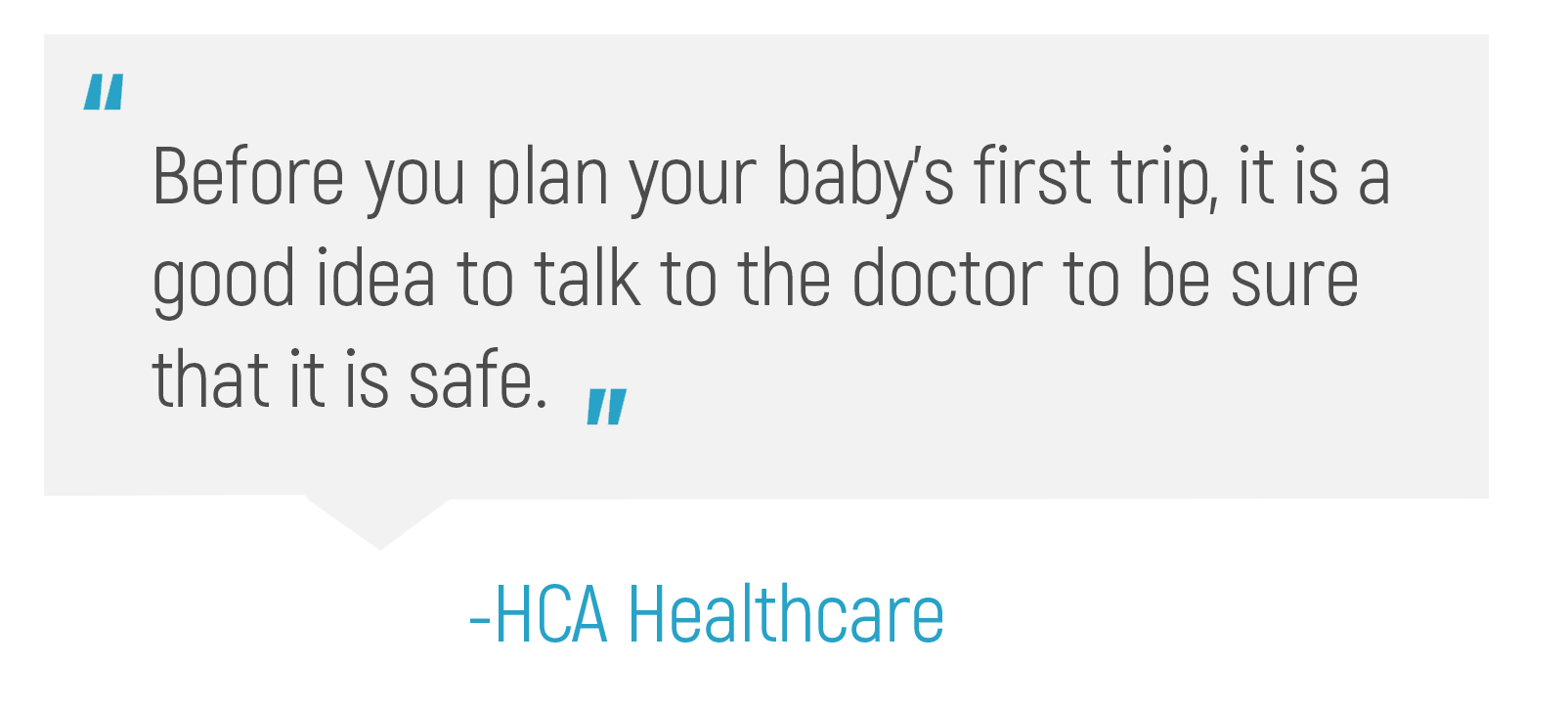
Store your luggage – just don’t forget about it
One of the great things about a train is there’s plenty of room to store things like umbrella strollers and backpacks. One of the problems is there’s so many different places to store things that you could forget.
It may sound like overkill, but if you have items tucked away here and there on a train, take pictures and refer to them when it’s nearly time to deboard.
Research your train ahead of time
“Do your research in advance, because some train cars can be specifically designated as a family car, with things like changing tables in the bathroom,” Brewer says. “We took a train from Oslo to Bergen, and the family car had a play area in it. It was amazing!”

Lean on the staff
Long-haul trains are fully staffed with extremely helpful people. Let them remove some of the stress of train travel.
If you have formula or breastmilk that needs to be refrigerated, let them know as soon as you get on. Similarly, let them know if you need a bottle heated.
Redcaps are also invaluable when it comes to getting all your bags and seats and strollers on and off the train.
Finally, tips of a couple dollars here and there go a long ways toward ensuring that the staff will be at your beck and call.
Get on and off promptly
The most stressful part of train travel with a newborn is getting on and off the train.
Know where and when you’re getting off, and prepare early. Gather together all your items and be ready to jump off when the doors open.
If you’re traveling with a full load, enlist the staff’s help. Put one person in charge of baby and all her immediate needs, and another in charge of the collateral stuff.
After you’re out, take a quick inventory. If something’s missing, alert the conductor immediately. They have the power to hold the train until everyone – and everything – is off.
FAQs
When can you travel on a train with a baby?
Basically as soon as you’re ready to take your baby out in public you can take them on a train. However, you should talk to your pediatrician before taking a long train trip with your newborn, since infants are more vulnerable to infections.
Also consider the following:
- Health conditions: Ensure that your baby is not experiencing any illness or discomfort that could be aggravated during the journey.
- Feeding and diapering: Make sure you have easy access to feeding and diapering facilities on the train. Some trains provide dedicated areas for these purposes.
- Comfortable seating: Choose seating arrangements that provide enough space for you and your baby. Seats with extra legroom or a private compartment are preferred. Special cars for parents and babies are available on some trains.
- Carry the essentials: This includes a fully stocked diaper bag and a sling or harness to keep your baby close to you.
Is it safe to travel with a newborn on a train?
Traveling on a train with a newborn can be safe if you take certain precautions. Here are some key tips to ensure a safe journey with your baby:
- Choose a designated infant-friendly car: Trains outside of the U.S. often have specific cars with facilities for parents traveling with infants, like diaper-changing stations and nursing areas. Opt for these compartments if available.
- Secure your baby: Use a sturdy and comfortable baby carrier or sling to keep your newborn close to you. Ensure the carrier is properly fastened and supports the baby's head and neck.
- Pack essentials: Bring plenty of diapers, wipes, extra clothes, blankets, and feeding supplies. Be prepared for any situation that may arise during the journey.
- Maintain hygiene: Keep your surroundings clean and sanitize your hands frequently. Wipe down the seat area around you with disinfectant wipes, and use sanitizer after touching door handles and other surfaces that may harbor germs.
- Be mindful of other passengers: While not a safety issue per se, respect the space and comfort of other passengers. Try to minimize disruptions by soothing your baby.
By following these guidelines, you can enjoy a safe and hassle-free train journey with your newborn.
The best places to travel with a baby
When planning a trip with a newborn, it's natural to prioritize their safety and well-being. You want to find a destination with:
- Things to do but also shady places to chill
- Changing stations and pumping areas that are clean and accessible
- Lodgings that are close by in case of meltdowns
Certain destinations offer a more conducive environment for traveling with a baby. Here are some of the safest places to travel with a newborn:
Baby-friendly resorts
Many resorts cater specifically to families with young children, providing amenities like baby pools, childproofed accommodations, and childcare services. These resorts often have knowledgeable staff trained to handle infants' needs.
Low-risk destinations
While COVID scares are almost entirely in the past, you still want to choose destinations with a low incidence of disease, high-quality medical facilities and good sanitation standards.
Check travel advisories from the State Department and other reputable sources, and consult healthcare professionals before finalizing your destination.
Family-oriented cities
Cities with a family-friendly reputation like Copenhagen, Tokyo, and Vancouver are excellent for newborns and their families. These cities typically have well-maintained parks, clean public facilities, and stroller-friendly streets.
Additionally, they may offer clean, safe, and convenient public transportation and numerous newborn-tolerant attractions.
Rural destinations
Tranquil and sparsely populated areas can minimize exposure to crowds and enhance the overall safety for your newborn.
Choose destinations with clean air, ample open spaces, and peaceful surroundings, such as countryside retreats or secluded beach towns. If they’re fairly close to home, so much the better.
Vacation rentals are great options for these destinations.
Regardless of the destination, it's crucial to maintain basic safety practices like:
- Practicing good hygiene
- Ensuring your modes of transportation are safe
- Being vigilant of your surroundings
The CDC recommends that you consult a pediatrician before departure, especially if the baby has chronic health conditions or is immunocompromised.
Finally, it’s important to pack all the essentials, including:
- Diapers
- Wipes
- Formula or breast milk
- Harness or sling
- A first-aid kit
With the right preparation, traveling with a newborn can be a safe and enjoyable experience for the whole family.
FAQs
What are the best places to travel with a baby in the U.S.?
Traveling with a newborn in the United States opens up a wide array of destinations that are family-friendly and cater to the needs of young children, like:
Orlando: For families with infants, Orlando’s theme parks provide amenities like baby-care centers, quiet areas for feeding, and stroller-friendly paths.
San Diego: With its pleasant weather and strollable attractions like the famous San Diego Zoo, San Diego is an ideal destination.
Asheville, N.C.: A popular vacation-rental destination, Asheville offers a serene and picturesque setting for a family getaway.
Washington, D.C.: The National Mall, the Smithsonian museums, and the city’s beautiful parks and gardens are great for families with newborns.
Honolulu: With its stunning beaches, calm waters, and family-friendly resorts, Honolulu offers a relaxed atmosphere for a memorable vacation with your newborn.
Seattle: Seattle offers a mix of urban attractions and natural beauty, and is super-walkable.
What are the best places to travel with a baby in Europe?
When choosing an European destination, consider the safety and baby-friendliness of the destination. Assuming your newborn is old enough to travel there, these are some of the best places in Europe to travel with a newborn:
Stockholm, Sweden: This city is easy to get around, safe, and has plenty of family-friendly attractions.
Copenhagen, Denmark: A top choice in our World’s Safest Cities rankings, Copenhagen is extremely walkable, with plenty of parks and resting places, and nice sights for grownups.
Italy: Italy is a family-friendly destination with plenty of attractions suitable for all ages.
United Kingdom: The U.K. is a baby-friendly destination with plenty of parks, museums, and attractions suitable for families.
When traveling with a newborn, consider the length of the flight. It is also important to take into account the baby's health and any special needs they may have.
THE REWARDS OF TRAVELING WITH A NEWBORN
Ultimately, traveling with an infant lets you view the journey from a new perspective, to align yourself to a less frantic pace.
Plus, as Brewer says, “When you do it young, it helps build your confidence as a parent. You know if you can handle all that baby stuff when you’re traveling, it doesn’t seem like such a big hill to climb when all of a sudden they’re teenagers and you want to take them on a trip.”
“You’ll never regret it,” Brewer concludes – and the knowledge that you can travel safely with a newborn makes it that much more rewarding.
Regardless of when or how you choose to travel with a newborn, choose Berkshire Hathaway Travel Protection for all your family trips.
Discover what makes our coverage special.
Get Your Free Travel Insurance Quote Now
All fields are required.
Questions About Travel Insurance?
Check out our online guide, "What Is Travel Insurance All About?" We've provided in-depth answers to all your travel insurance questions, starting with the basics.